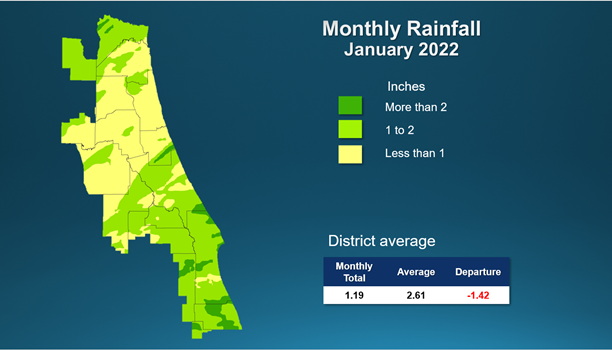Below-average rainfall Districtwide in February

A map illustrates rainfall conditions in December across the St. Johns River Water Management District.
PALATKA, Fla., March 8, 2022 — February brought well below-average rainfall to the region, with signs of drought showing in the central and northern region of the District as reported in the U.S. Drought Monitor. The Districtwide total of 1.19 inches is less than half the average rainfall for February.
A full report outlining February’s hydrologic conditions was presented at the District’s Governing Board meeting Tuesday. Highlights include:

A map illustrates rainfall conditions in February across the St. Johns River Water Management District.
Rainfall
- Districtwide, February rainfall averaged 1.19 inches, which is 1.76 inches below the average for the month.
- The county with the highest rainfall total was Clay, which received 2.07 inches of rain.
- Districtwide, the cumulative rainfall total for the past 12 months is 48.72 inches, which is 2.29 inches below the long-term average.
Groundwater
- Upper Floridan aquifer conditions (groundwater levels) at the end of February were a mix of high and normal conditions across most of the District. Water levels in many of the wells across the District decreased more than 10 percentile points.
- Groundwater levels are at the 65th percentile Districtwide. This means that since 1980, aquifer levels have been higher than they currently are about 35 percent of the time.
Surface water flows
- On March 1, flow in most stations across the District was in the average or low range. The two exceptions were the Wekiva River near Sanford and the St. Johns River near Jacksonville, where flow was in the very low range for this time of year.
- On March 1, flow in the St. Johns River’s headwaters at the Melbourne station was 121 million gallons per day (mgd) (44th percentile).
- Flow in the Econlockhatchee River near Chuluota was in the average range at 57 mgd (42nd percentile).
- Flow in the Wekiva River near Sanford was in the very low range at 109 mgd (1st percentile).
- Flow at the St. Johns River DeLand station was in the average range at -491 mgd (52nd percentile). Prevailing meteorological conditions combined with low rainfall in the drainage basin resulted in predominantly reverse flow on March 1.
- Flow in the Ocklawaha River, the largest tributary to the St. Johns River, was in the average range at 473 mgd (26th percentile).
- Flow at the St. Johns River near Satsuma station was in the average range at -4,325 mgd (38th percentile). Prevailing tidal and meteorological conditions combined with low rainfall in the drainage basin resulted in predominantly reverse flow on March 1.
- Flow in the St. Marys River near Macclenny was in the average range at 132 mgd (30th percentile).
Lake levels
- Lake Brooklyn water levels decreased 0.4 foot to 99.9 feet in February and remains below average.
- Lake Weir water levels had no change from last month and remains at 53.4 feet.
- Lake Winnemissett water level decreased 0.1 foot from last month to 56.4 feet.
- Lake Apopka water levels decreased by 0.1 foot to 65.6 feet in February. Lake Apopka is part of a system with water control structures that are operated by the District.
- Blue Cypress Lake levels decreased to 22.1 feet. Blue Cypress is also part of a system with water control structures that are operated by the District. During April and May, the regulation schedule levels drop in preparation for the summer wet season.
Spring flows
- The mean monthly flow at Silver Springs decreased to 709 cubic feet per second (cfs), or 458 mgd, which is a 24 cfs decrease from January’s mean.
- At the Blue Spring station in Volusia County, the mean monthly flow was 160 cfs, or 103 mgd.
- At Rock Springs, the monthly mean flow decreased 1 cfs to 58 cfs (38 mgd), which is in the normal range for February.
- Mean monthly flow at Wekiwa Springs decreased slightly to 62 cfs (40 mgd), which is in the normal range for the time of year.
To learn more about rainfall totals and other hydrologic data collected, visit sjrwmd.com.
Visit WaterLessFlorida.com for tips to help landscapes thrive while saving water and money. Follow the water conservation conversation at #sjrwmd #waterconservation #savewater.

